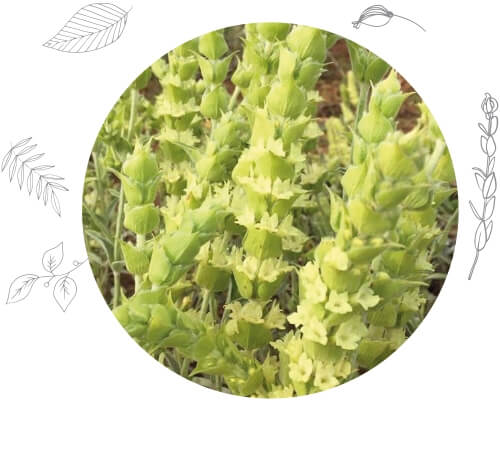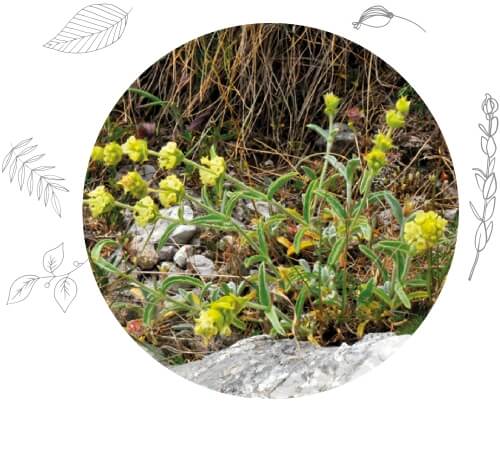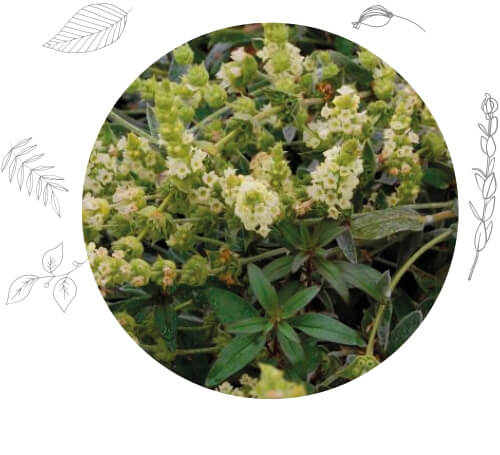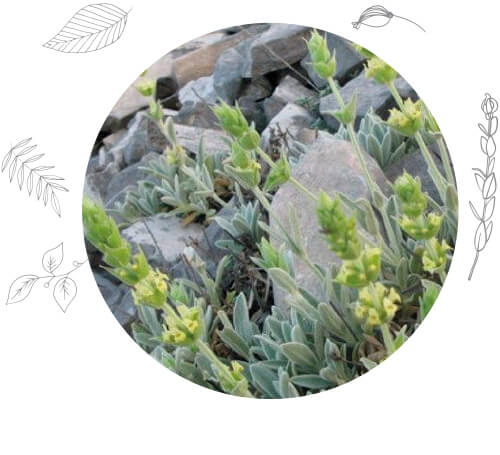-
Free Shipping in Greece over €30!

-
Shipping within 24 hours!

-
Worldwide shipping!



THE GREEK MOUNTAIN TEA
Greek mountain tea is the most popular and the most widespread Greek herb. There are about 10 species with the best quality that of the mount Olympus species. Greek mountain tea has antimicrobial, anti-inflammatory, antioxidant properties and strengthens the immune system. It is also rich in iron.
Names - Species
Mountain tea is the most popular and most widespread Greek herb. It is found as a native plant in most of the mountainous and semi-mountainous parts of Greece. Its scientific name is Sideritis spp. According to one version, this name derives from the word iron (sideros in Greek) because of its ability to heal wounds caused by iron objects. According to another, it was named because it is a natural source of iron, since tea made from it contains large amount of iron.
The most important species in Greece are:
1. Vlachiko tea (Sideritis αthoα). It is grown in mountain Athos, in Pindos and the mountain parts of Samothraki island.
2. Malevos tea or Taygetos tea (Sideritis clandestine). It is found as a native plant on rocks, in the alpine and sub-alpine regions of Malevos, of Taygetos and of Kylini.
3. Olympus tea or herb of the Gods (Sideritis scardica). It is the most famous and the one with the best quality. It is found as a native plant on the rocky soils on the sub-alpine zone of mount Olympus, Kissavos and Pelion.
4. Parnassos tea or Velouchi tea (Sideritis rαeseri Boiss & Heldr.). It is found as a native plant on mount Parnassos, Tymfristos (Velouchi) and other mountains of Aitolia, Dorida and Fthiotida.
5. Crete tea (Sideritis syriaca L.) or Malotira. The name malotira originates from the Italian words male (disease) and tirare (pull) because in the Venetian Crete they considered it a remedy for colds and respiratory diseases. It is found as a native plant on the high mountains of Crete, mainly in the White Mountains and in Psiloritis, in altitudes of 1,300 -2,000m.
6. Evia tea (Sideritis euboes Heldr.) or tea from Delfi. It is found abundant as a native plant in mountain Dirfys at an altitude of 1,000-1,500m. (Diasselo Dirfys, Scottini, Seta, Stropones, Metochi, etc.). It is also found in Xerovouni of Evia, at an altitude of 1,400m.

Mountain tea “Olympus”
Botanical description
It belongs to the family of the lamiaceae and in the genus Sideritis, which includes about 10 species. The Greek mountain tea is a single-year or perennial herb degraded at the base and hairy. They are usually very fragrant due to the essential oil content. The leaves are jagged and the flowers are white or yellow and usually form ear. The cap is conical with 10 ribs and 5 teeth arranged on two lips, ending in three lobes, of which the middle one is the largest. The upper lip consists of two inherent petals, while the lower lip results in three lobes, of which the middle one is the largest. The stamens are four and the front two are more elongated than the other two. The post ends in two uneven spots. The ovary is two-sided, while with false diaphragms it becomes four-sided. The fruits are four curries enclosed by a semen.

Mountain tea “Parnassos”
History
In Greece it has been known since the ancient times and is mentioned by Theophrastos (372-287 BC) and Dioskourides. Dioskouridies describes three Siderites, of which the two are not related to the genus siderites spp. Hippocrates recommended it as a tonic because of its high iron content.
Linneos was the first to describe the siderites, while Webb and Berthelot in 1836 claimed to be a separate genus, which they called Leucophae. Bentham in 1948 considered siderites as a section of the genus Sideritis and called them Marrubiastrum (Mendoza-Hener 1977) and Bolle returned the Linneos’ taxonomy. Finally, Mendoza-Hener suggested that the siderites can be distinguished in two sub-genuses, Sideritis and Marrubiastrum; in the latter the various species occurring in the coastal regions and the Canary Islands can be classified respectively.
Generally in the ancient times, the name sideritis refers to several plants, which were thought to have the ability to heal the serious wounds of iron objects such as arrows or swords, etc. Among others, Dioskourides' first sideritis got his name from the teeth of the flower bud, which resemble a spear. Dioscorides used it for wound healing.

Mountain tea “Crete”
Pharmacological Properties
A number of studies have been conducted from time to time on both extracts of the genus Sideritis and chemical compounds isolated from them to assess their therapeutic properties. The most important pharmacological properties of mountain tea are:
• Antimicrobial activity. The action against bacteria, viruses and yeasts is important. This action is mainly due to the plant's essential oils containing monoterpenic hydrocarbons. Of the plants studied most important were those with essential oils rich in apipenium and carvacrol. The S. raeseri species does not contain many monoterpenes and it is therefore inactive.
• Anti-inflammatory activity. There are many studies on the anti-inflammatory action of extracts of the genus Sideritis. It is mainly due to the groups of flavonoids, terpenes and lipids. Phytosterols, α- and β-amines and diterpenes act against the inflammation.
• Antioxidant activity. Sideritis exhibits powerful antioxidant activity. In particular, plant extracts with ethyl acetate and butanol. The antioxidant activity is due to the presence of polyphenolic compounds which have the ability to block free radicals.
Due to the antioxidant action and its currently recognized positive effect on strengthening the immune system, mountain tea strengthens the immune system. This enhancement is also magnified by its antimicrobial and anti-inflammatory action.
The high iron contents improve the quality of blood and its functions.

Mountain tea “Evia”
Bibliography
1. Alcaraz M.J., Hoult J.R.: Effects of hypolaetin-8-gIucoside and related flavonoids on soybean lipoxygenase and snake venom phospholipidase Α2.: Arch lnt Pharmacodyn Ther, 1985 Ναv, 278:1, 4-12
2. Alcaraz M.J., Ferrandiz Μ.Ι. and Villar Α FIavonoid Inhibition of Soybean Lipoxygenase Pharmazie 41(1986) Η4 299-300
3. Alcaraz M.J., Jimenez M.J., Valverde S., Sanz J., Rabanal R.M.: Antiinflammatory compounds from Sideritis java/ambrensis n-hexane extract J Nat. Prod. να52, (5):1088-1091, Sept-Oct 1989
4. Barberan F.AT., Tomas F. and Ferreres F.: Isoscutellarein-7-0-[allosyl (1 & 2) GIucoside] from Sideritis leucantha J Nat. Prod. ναl48, (1):28-32, Jan-Feb 1985
5. Barberan Francisco ΑΤ., Manez Salvador and Villar Angel: Identification of Inflammatory agents from Sideritis Species Growing in Spain J. Nat. Prod. ναl 50, (2):313-4, Mar. Apr. 1987.
6. de las Herras Beatriz and Hoult J.R.S.: Non-Cytotoxic Inhibition of Macrophage Eicosanoid Biosynthesis and Effects on Leukocyte Functions and Reactive Oxygen Species of Two ΝονθΙ Anti-Inflammatory Plant Diterpenoids P/anta Med. 60 (1994): 501-506
7. de las Herras Β., Vivas J.M., Villar Α.: Anti-inflammatory activity of Sideritis javalambrensis extracts J ethnopharmacol41 (1994) 15-17
8. Diaz R.M., Garcia-Granados Α, Moreno Ε., Parra Α, Quevedo-Sarmiento J., Saenz de Buruaga Α, and Saenz de Buruaga J.M.: Studies on the Relationship of Structure to Antimicrobial Properties of Diterpenoid Compounds from Sideritis Planta Medica 1988
9. Ferrandiz Μ.Ι., Ramachandran Nair Ag. and Alcaraz M.J.: Inhibition of sheep platelet arachidonate metabolism flavonoids fron Spanish and Indian medicinal herbs Pharmazie 45(1990) Η3 206-208
10. Gergis V, et al: Antimicrobial Activity of essential oils from greek Sideritis species Pharmazie, 1990 Jan
11. Huguet Ana Ι., Manez Salvador, and Alcaraz Maria Jose: Superoxide Scavenging Properties of Flavonoids in a Non-Enzymatic System Ζ. Naturforsch. 45c, 19-21 (1990)
12. Καββαδά Δημ. Σ.: Εικονογραφημένο Βοτανικόν Φυτολογικόν Λεξικόν: Τόμος Η - Τεύχος 120 σελ. 3614-7
13. Navarro Α, de las Heras Β., Villar ΑΜ. Q: Andalusol, a diterpenoid with anti-inflamatiry activity from Sideritis foetens Clemen: Ζ. Naturforsch [C], 1997 Νov. 52: 11-12, 844-9
14. Palomino ο.Μ., Sollhubuer Μ., Carretero Ε. and Villar Α.: Isoscutellarein 7-glucosyl(1 & 2) xyloside from sixteen species of Sideritis: Phyrochemistry, νol 42, (1):101-102, 1996
15. Pang L., de las Heras Β. and Hoult J.R.S.: Α Novel Diterpenoid Labdane from Sideritis javalambrensis Inhbits Eicosanoid Generation from Stimulated Macrophages But Enhances Arachidonate Release Biochem Pharmac, ναl 51, pp 863-868, 1996
16. Polunin Ο. & Huxley Α.: Flowers of the Mediterranean 1967 Chatto and Windus London 159-160
17. Polunin Ο.: Flowers of Greece and the Balkans, a field guide. Oxford University Press 1980 391-2, ISBN Ο 19217626 9
18. Quer P.F.: Plantas Medicinales el Dioscorides Renovado, Editorial Labor, S.A. 1962: 661-3
19. Rios J. L., Manez S., Paya Μ. And Alcaraz Μ. J.: Antioxidant Activity of Flavonoids from Sideritis javalambrensis Phytochem ναl. 31 (6):1947-1950, 1992
20. Wellmann Μ.: Pedanii Dioscuridis Anazarbei de Materia Medica Libri Quinque, ναl ll,MCML νlll, Βerαlίnί apud Weidmannos
21. Venturella Ρ., Bellino Aur. And Marino Μ-L: Three acylated flavone glycosides from Sidetitis Syriaca Phytochem ναl. 38(2) :527-530, 1995
22. Villar Α., Gasco Μ.Α. and Alcaraz M.J.: Anti-inflammatory and anti-ulcer properties of hypolaetin-8-glucoside, a novel plant flavonoid J. Pharm. Pharmacol, 1984, 36: 820-823, 1984
23. Villar Α., Recio M.C., Rios J.L. and Zafra-Polo M.C.: Antimicrobial Activity of Essential Oils from Sideritis species Pharmazie 41(1986) Η4 198-199
24. Gonzalez-Burgos E., Carretero M.E., Gomez-Serranillos M.P., Sideritis spp.: Uses, chemical composition and pharmacological activities A Review, Journal of Ethnopharmacology, 135 (2011) 209–225.
25. Ανάσης Ε., Τα φαρμακευτικά βότανα της Ελλάδας: ονομασία, ιστορία, βοτανικοί χαρακτήρες, χρησιμότητες, φαρμακευτικές ιδιότητες, καλλιέργεια. Μακρής, 1976.
26. Θανασούλια Β., Σιατής Ν., Περί βοτάνων: πλήρης οδηγός βοτάνων, μορφολογία, ιδιότητες, τρόποι χρήσης. Αγγελάκη, 2008.
27. Barber J., Ortega J.F., Guerra A.S., Turner K.G., and Jansene R.K,, Origin of Macaronesian Sideritis L. (Lamioideae: Lamiaceae) inferred from nuclear and chloroplast sequence datasets, Molecular Phylogenetics and Evolution 23 (2002) 293–306.
28. Koedama A., Volatile Oil Composition of Greek Mountain Tea (Sideritis spp.), J. Sci. FoodAgric., 36 (1986) 681-684.
29. Charami M.T., Lazari D., Karioti A., Skaltsa H., Hadjipavlou-Litina D., and Souleles C., Antioxidant and Antiinflammatory Activities of Sideritis perfoliata subsp. Perfoliata (Lamiaceae), Phytother. Res. 22 (2008) 450–454.
30. N. Aligiannis, E. Kalpoutzakis, I. B. Chinou, and S. Mitakou, E. Gikas and A. Tsarbopoulos, Composition and Antimicrobial Activity of the Essential Oils of Five Taxa of Sideritis from Greece J. Agric. Food Chem., 49 (2001) 811-815.
31. Τodorova M, Trendafilova A. Sideritis scardica Griseb., an endemic species of Balkan peninsula: Traditional uses, cultivation, chemical composition, biological activity. J. Ethnopharmacol. 2014;152: 256-265.
32. Petreska J, Stefkov G, Kulevanova S, et al. Phenolic compounds of mountain tea from the Balkans: LC/DAD/ESI/MS Profile and Content. Nat. Prod. Commun. 2011;6(1): 21-30.
33. Gabrieli CN, Kefalas PG, Kokkalou EL. Antioxidant activity of flavonoids from Sideritis raeseri. J. Ethnopharmacol. 2005;96: 423-428.
34. Danesi F, Saha S, Kroon PA, et al. Bioactive-rich Sideritis scardica tea (mountain tea) is as potent as Camellia sinensis tea at inducing cellular antioxidant defences and preventing oxidative stress. J. Sci. Food Agric. 2013;93: 3558-3564.
35. Aligiannis N, Kalpoutzakis E, Chinou IB, et al. Composition and antimicrobial activity of the essential oils of five taxa of Sideritis from Greece. J. Agric. Food Chem. 2001;49(2): 811–815.
36. Tadić VM, Djordjević S, Arsić I, et al. Anti-inflammatory and antimicrobial activity of Sideritis scardica extracts. Planta Med. 2007;73(9): 98.
37. Tadić VM, Jeremić I, Dobrić S, et al. Anti-inflammatory, gastroprotective and cytotoxic effects of Sideritis scardica extracts. Planta Med. 2012;78: 415-427.
38. Đorđević S, Blagojević S, Sekulović D, et al. The analysis of mineral content in active components and the preparation of phytopreparations for anemia prevention. Arh. Farm. 1993;43: 225–231.
39. Jasenka Piljac Zegarac, PhD. Greek Mountain Tea (Sideritis L.): Functional Components and Biological Activity
40.Danesi F, Saha S, Kroon PA, et al. Bioactive-rich Sideritis scardica tea (mountain tea) is as potent as Camellia sinensis tea at inducing cellular antioxidant defences and preventing oxidative stress. J. Sci. Food Agric. 2013;93: 3558-3564.
41. B Feistel, B Walbroel, J Pahnke. Extract preparation from Sideritis scardica enhances memorizing skills of mice in Morris water maze.













